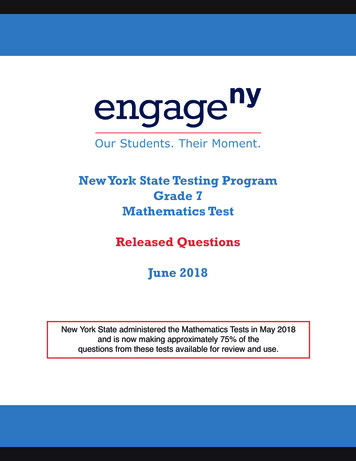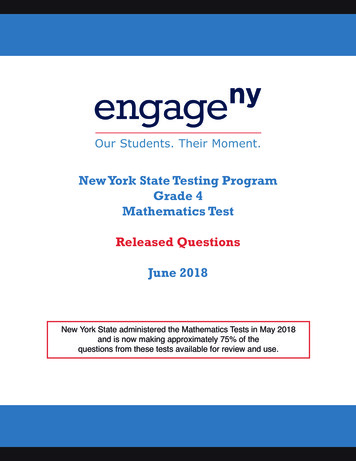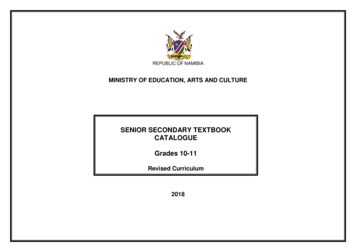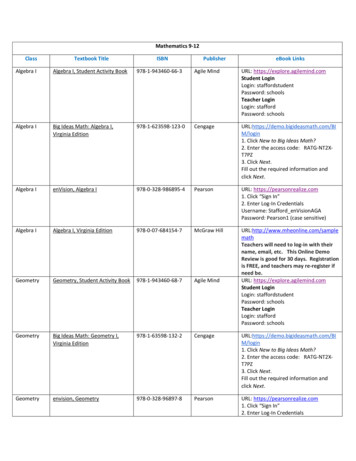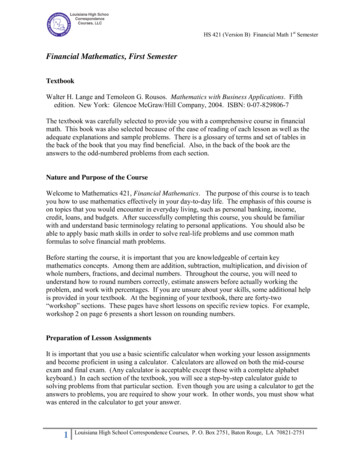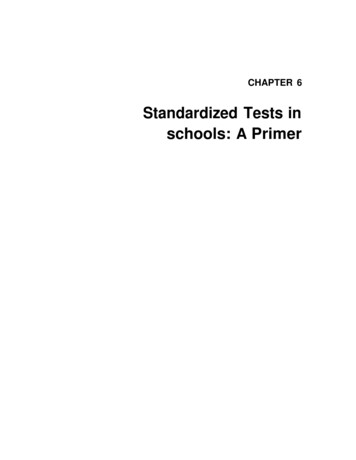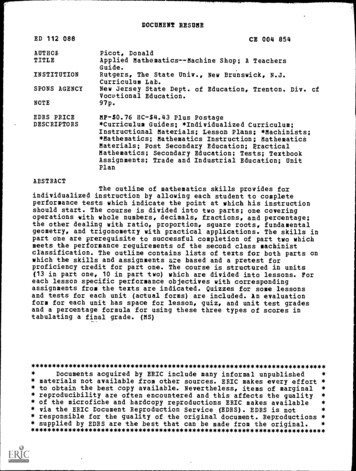
Transcription
DOCUMENT RESUMEED 112 088AUTHORTITLECE 004 854Picot, DonaldApplied Mathematics--Machine Shop; A TeachersGuide.INSTITUTIONSPONS AGENCYRutgers, The State Univ., New Brunswick, N.J.Curriculum Lab.New Jersey State Dept. of Education, Trenton. Div. ofNOTEVocL'tional Education.97p.EDRS PRICEDESCRIPTORSME- 0.76 HC- 4.43 Plus Postage*Curriculum Guides; *Individualized Curriculum;Instructional Materials; Lesson Plans; *Machinists;*Mathematics; Mathematics Instruction; MathematicSMaterials; Post Secondary Education; PracticalMathematics; Secondary Education; Tests; TextbookAssignments; Trade and Industrial Education; UnitPlanABSTRACTThe outline of mathematics skills provides forindividualized instruction by allowing each student to completeperformance tests which indicate the point at which his instructionshould start. The course is divided into two parts; one coveringoperations with whole numbers, decimals, fractions, and percentage;the other dealing with ratio, proportion, square roots, fundamentalgeometry, and trigonometry with practical applications. The skills inpart one are prerequisite to successful completion of part two whichmeets the performance requirements of the second class machinistclassification. The outline contains lists of texts for both parts onwhich the skills and assignments are based and a pretest forproficiency credit for part one. The course is structured in units(13 in part one, 10 in part two) which are divided into lessons. Foreach lesson specific performance objectives with correspondingassignments from the texts are indicated. Quizzes for some lessonsand tests for each unit (actual forms) are included. An evaluationform for each unit has space for lesson, quiz, and unit test gradesand a percentage formula for using these three types of scores intabulating a final grade. *************************Documents acquired by ERIC include many informal unpublished* materials not available from other sources. EPIC makes every effort ** to obtain the best copy available. Nevertheless, items of marginal ** reproducibility are often encountered and this affects the quality ** of the microfiche and hardcopy reproductions ERIC makes available** via the ERIC Document Reproduction Service (EDRS). EDRS is not* responsible for the quality of the original document. Reproductions ** supplied by EDRS are the best that can be made from the *******************************
State of New JerseyDepartment of EducationDivision of Vocational EducationAPPLIED MATHEMATICSMACHINE SHOPA Teachers GuideBehavioral ObjectivesIndividualized CurriculumDonald Picot, InstructorCharles Green, SuperintendentWarren County Area Vocational & Technical High SchoolWashington, New JerseyVocational-TechnicalCurriculum LaboratoryRutgers - The State UniversityBuilding 4103 - Kilmer CampusNew Brunswick, New Jersey
DIVISION OF VOCATIONAL EDUCATIONSTEPHEN POLIACIK, ASSISTANT COMMISSIONERCURRICULUM LABORATORYRUTGERS - THE STATE UNIVERSITYBUILDING 4103 - KILMER CAMPUSNEW BRUNSWICK, NEW JERSEY4
CONTENTSMachine Shop Applied Mathematics IPageIntroduction to Mathematics I1Reference Books for Mathematics I2Pretest3Unit I- NumbersUnit II- Addition of Whole Numbers and Decimals611Unit IIISubtraction of Whole Numbers and Decimals14Unit IVMultiplication of Whole Numbers and Decimals17Unit VDivision of Whole Numbers and Decimals21Unit VI- Common Fractions25Unit VII- Addition of Fractions29Unit VIII - Subtraction of Fractions32Unit IX- Multiplying Fractions35Unit X- Division of Fractions38Unit XI- Fraction Problems Involving Combined Operations41Unit XII- Decimal Fractions44Unit XIII - Percentage47Machine Shop Applied Mathematics IIIntroduction to Mathematics II50Reference Books for Mathematics II51Unit I52Unit IIRatio and Proportion- Squares, Square Roots, and Their Application555
PageUnit III- Regular Polygons59Unit IV- Circles63Unit V- Arcs and Circles-66Unit VI- Fundamentals of Trigonometry69Unit VII- Use of Trigonometric Tables74Unit VIII- Solution of Right Triangles77Unit IX- Practical Applications of Trigonometry84Unit X- Computing Taper per Unit of Length89ii
INTRODUCTIONMACHINE SHOPAPPLIED MATHEMATICS IThe following is a performance outline for Machine Shop Mathematics I.Each student must demonstrate a capability in all the performances listedto complete the course. These math skills will equip the student to makethe necessary calculations for machine tool operation, for personal needs,and as a prerequisite to Machine Shop Mathematics II.The outline is constructed for individual instruction. All studentswill start the course by completing tests until they reach their presentlevel of performance. Each individual's instruction will start at thatpoint and continue until he has mastered the performances outlined.Completion of this course of study will permit the student to pursueMachine Shop Mathematics II or take the option of other electives.Much of the learning will be under the student's own direction. Hisprogress will depend largely on his personal effort and ability.Eachclass member is expected to give his best effort, using class time to maximum advantage. The benefit each student receives from the instructor'sguidance, advice, and knowledge wal depend to a large degree on a matureattitude on the part of each individual and the class as a whole.The student must be convinced that the level of his math skills willhave a direct impact on his shop progress. The Machine Shop course reliesstrongly on 4powledge of math and other related subjects. Specific shopperformance requirements cannot be met without these background courses.This course should be an easy step-by-step learning process thatshould be easily mastered by the conscientious and able student. Whenhe has mastered his related and shop skills, he will be recommended for aRemind the students: "You 'learn so thattrial "earning" in the trade.you may earn'".4,*1
REFERENCE MATERIALSFORCOURSE OF STUDY OUTLINEMACHINE SHOPAPPLIED MATHEMATICS I1.Basic Mathematical Skills (BMS)Loyce C. GossageMcGraw-Hill Book Company2.Mathematics for Technical and Vocational SchoolsStade, Margolis & BoyceJohn Wiley and Sons, Inc.3.Basic Vocational Mathematics IC. M. SantoliVocational-Technical Curriculum LaboratoryRutgers - The State University4.Essential Business Mathematics (EBM)Llewellyn R. SnyderMcGraw-Hill Book Company5.Business and Consumer Arithmetic (B&CM)Olson and McNallyPrentice Hall, Inc.2
NameDatePRETESTMachine Shop Applied Mathematics INOTE TO STUDENT:A.B.C.To earn credit for Math I, proficiency must be shown inall sections.Reduce to lowest terms:Answer below:1.14/161.2.24/322.3.6/83.4.3 10/164.5.16/645.Convert to the required fraction:6.1/2 to 4ths6.7.1/2 to 10ths7.8.3/8 to 32nds8.9.5/8 to 64ths9.10.7/8 to 16ths10.Add and reduce to lowest terms:11.1/2 1/411.12.3/16 1/812.13.1 1/4 1/413.14.7/8 1/1614.15.10 1/8 1/3215.039
D.E.Multiply and reduce to lowest terms:16.3/4 x 516.17.2/3 x 5/717.18.3/4 x 8/918.19.8/11 x 5/1219.20.2 1/2 x 3 1/420.Divide and reduce to lowest terms:22.3/42/321.522.23.1 l equivalent correct to 3 decimal places:3/426.27.5/1627.28.1 5/828.29.1/3229.30.1/6430.Add.Give answers in decimals.31.1.500 .250 - .531.32.250 1/232.33. 2.875 .125 - 3.033.7/8 .125 - 0.75034.34.35. 1.015 .625 - .04535.4
IH.Find the percentage:36.50% of 336.37.5% of 337.38.1% of 10038.39.6% of 50039.40.10% of 1,00040.
COURSE OF STUDY OUTLINEMACHINE SHOPAPPLIED MATHEMATICS ISpecific PerformancesAssignmentsUnit I - NumbersLesson 1. Meaning of Numbersa. Defines a digit as asingle number.a)Basic Vocational Math,Part I,page 2.b. Defines a unit as ab)BVM-I, page 3.c)BVM-I, pages 3 & 4Groups multiples of tenin the tens position.d)BVM-I, pages 5 & 6Etc.e)Lesson 1 - QuizBVM-I, pp. 7-13Handout I-1single one.c. Defines the place valueof a number in terms ofits position in relationto the decimal point.d. Places numbers in theproper numerical position.Groups the numbers 2-9in the units position.6
NameDateMACHINE SHOPAPPLIED MATHEMATICS IQuizUnit I, Lesson 11. A digit is the same as (choose one)a)b)a unita single numbera single objectany number of objectsc)d)2. Give the place value for the seven places preceding the decimal point.11I0000000,oi!*DecimalPointAnswer3. There areunits in the tens place.4. There aretens in the hundreds place.5. There arehundreds in the thousands place.7A a)-11. !J
COURSE OF STUDY OUTLINEMACHINE SHOPAPPLIED MATHEMATICS IUnit ILesson 2Lesson 3(continued)Reading and Writing Whole Numbersa. Refers to any number group byname such as: units, tens,twenties, hundreds, andthousands.a) BVM-I, pages 14-16b. Arranges numbers in groups ofthree digits beginning fromthe decimal point and placesa comma between each group.b) BVM-I, pp. 17-19BVM-I, p. 20, drill #1c) Lesson 2, Quiz - BasicMath Skills, pp. 3 & 4prob. 1-10, prob. 31-38,prob. 42 and 43.Rounding Off Numbersa. Defines rounding off as thesimplifying of a numbera) BVM-I, pp.23 and 24.b. Rounds off by selecting thedesired place, omits allnumbers to the right of thatplace, substituting zeros.b) BVM-I pp. 24 (bottom) -26(prob. 1-5 each)If the last remaining numberon the right is1. Five or greater,adds 1c) Lesson 3 Quiz BVM-Ip. 27 (1-5)2. Four or less, leaversthe sameLesson 4Unit Testa) Handout-Unit I test8
NameDateMACHINE SHOPAPPLIED MATHEMATICS I.',Unit I - TestWrite the following numbers in numerals with commas inserted. (10 pts each)1. Twenty-four1.2. One hundred thirty-five2.3. Two thousand, nine hundred and nine3.4. Fourteen million, six thousand and ten4.5. One hundred one thousand and one5.Round off the following numbers to the third place before the decimal.(10 pts .9.04 l.A.c.)
Name:Applied Mathematics IEvaluation sheet for - Unit I - NumbersTitleLesson #Level(Quiz -Comment)1Meaning of Numbers (Lesson 1)2Reading & Writing Whole Numbers Quiz - Lesson 23Rounding Off Numbers4Unit TestEvaluation:IAlBjCJDLesson 25%Quiz 25%Test 50%Unit GradeDate completed.14 rb.,.)10a
Unit II - Addition of Whole Numbers and DecimalsLesson 1.Introduction to Additiona. Defines the numbers beingadded as the addend andthe answer as the sum.Lesson 2.Addition Factsa. Demonstrates memorizationof the 100 primary combinations of the digits(0,1.9).Lesson 3.a) Business and Consumer Math.pp.59-60. Work prob. 1-20b) EBM, p. 16, work prob.l -13c) BMS, p. 137, part A,prob. 1-10Checking Additiona. Uses the reverse-ordermethod to check addition.Lesson 5.a) BMS, p 11, part 4A (Thisis a speed exercise; seeyour instructor beforestarting.)b) BMS, p 195, part A Quiz(see above instructions.)Addition of Larger Numbersa. Aligns the decimal point ina vertical column.b. Finds the sum of long columns.Lesson 4.a) Basic Math Skills, p. 9Unit Test11EBM, p. 13BMS, pp 17-18c) EBM, p. 16, part Ba)b)
NameDateMACHINE SHOPAPPLIED MATHEMATICS IUnit II - TestFind the sum; check your 2513)3.75049.254).8121.0613.531.0075)Ten (10) points each.,3.31256)40.16 108.67 54.047 80.0313.5007)2.8 9.04 16.009 28.17648).58 95.4 16.009 1.0079)1.0025 .7514 .3095 .200010.00010.0001510)1.062 .438 .500 1.312Write answers 5
Applied Mathematics IName:Evaluation sheet for Unit ITAddition (f WholP NnmhPrs k DocimalsTitleLesson #Level1Introduction to Addition2Addition Facts (Quiz - Les. 2)3Addition of Larger Numbers4Checking Addition5Unit TestAB CDEvaluation:Lesson 25%Quiz 25%Test 50%Unit GradeDate completed13Comment
Unit III- Subtraction of Whole Numbers and DecimalsLesson 1.Introduction to Subtractiona. Identifies the largernumber as the minuend.a) BMS, p. 27b. Identifies the number tobe subtracted as thesubtrahend.c. Calls the answer thedifference.Lesson 2.Subtraction Factsa. Demonstrates memorizationof the 100 subtractionfacts.Lesson 3.Proving Accuracya. Uses the reverse-order methodto check subtraction.Lesson 4.Lesson 5.a) BMS, pp. 29-30 (This isa speed exercise; seeyour instructor beforestarting.)b) Lesson 2 Quiz BMS, p. 203Quiz 12a) BMS, pp 31-32b) EBM, p. 20, part CSubtracting Decimal Fractionsa. Aligns decimal pointsvertically.a) Math for Tech. & Voc. Schoolspp. 40-41, prob. 1-10Unit Testa) Handout - Unit III Test14
NameDateMACHINE SHOPAPPLIED MATHEMATICS IUnit III - TestSubtract; check your answers.Ten (10) points each.Write answer here:Problem:3.051)1.55.0072.406.8103.508.71 - )7.737.658 - 402.787)8.200.4 - 89.9978)9.486.273 - 35.1069)10.271.43 - 58.717210)53.9182)1521
Name:Applied Mathematics IEvaluation sheet for Unit IIISubtraction of Whole Numbers and DecimalsLevelTitleLesson #1Introduction to Subtraction2Subt. Facts Quiz - Lesson 23Proving Accuracy4Subtracting Decimal Fractions5Unit TestA BCDEvaluation:Lesson 25%Quiz 25%Test 50%Unit GradeDate completed16"1I,;14 NalComment
Unit IV - Multiplication of Whole Numbers and DecimalsLesson 1. Introduction to Multiplicationa. Uses multiplication as ashort method of addingequal numbers.b. Refers to the numbers involved in the multiplication as factors.a) BMS, p. 43b) Business & ConsumerArithmetic, pp. 24-25;read introductorystatement onlyc. Refers to the answer as theproduct.Lesson 2. Multiplication Factsa. Can demonstrate the 100primary multiplicationfacts.a) BMS, pp. 45-46. This isa speed exercise; seeyour instructor beforestarting.Lesson 3. Multiplication with One-DigitMultipliersa. Will carry figures wherenecessary.a) BMS, pp. 47-48b) Lesson 3 Quiz /120;BMS, p. Q211Lesson 4. Multiplication with Two-andThree-Digit Multipliersa. Will find partial productswhen multiplying by two ormore digits.a) EBM, pp. 49-50b) B&CM, p. 25, group 1c) B&CM, pp. 25-26,group 2 (1-15)b. Will indent partial products in solving for theproduct.d) Lesson 4 Quiz 121,BMS, p. Q211Lesson 5. Multiplication with Zero inEither Factora. Knows that when zero ismultiplied by any numberthe product is zero.b. Knows that when any numberis multiplied by zero, theproduct is zero.a) EBM, p. 51 (see examplesC & D) Work prob. 1f24-50b) EBM, p. 52 (see examplesC & D) Work prob. #24-50c) Lesson 5 Quiz 1122,BMS, p. Q21317'71'1Pm It,"
Lesson 6. Shortcuts in Multiplicationa. Can,when multiplying by 10,100, 1000, etc. move thedecimal point in the multiplicand to the right as manyplaces as there are zeros inthe multiplier.a) BMS, p. 57. Read first twoparagraphs. Work prob.l -40b) Lesson 6, Quiz 4125BMS, p. Q215, part ALesson 7. Checking Multiplicationa. Will use the reverse-ordermethod to check multipli-a) EBM, p. 25. See exampleof transposing factorscation.b) BMS, pp. 53-54 prob. 1-10(use reverse-check method)Lesson 8. Decimals in Multiplicationa. Will give the product asmany decimal places asthere are decimal placesin the two factors together.Lesson 9. Unit Testa) EBM, pp. 23-24 example 1&2b) Math for Voc. & Tech.Schools,p. 42, prob. 2-8 set A,2-8 set B, 21-40a) Handout - Unit IV Test"7 .4rim- x18
NameDateMACHINE SHOPAPPLIED MATHEMATICS IUnit IV - TestMultiply; check your answers.Five (5) points each.1.15 x 46.78 x 1411.0.8 x 0.916.18 x 1002.13 x 67.86 x 1112.0.32 x 0.417.92 x 10003.11 x 88.31 x 20013.0.25 x 0.37518.7.2 x 1004.51 x 109.567 x 5014.3.1416 x 519.063 x 1005.14 x 1210.52 x 414715.0.813 x 420.721 x 10Write answers 10.20.19t
Name:Applied Mathematics IEvaluation sheet for Unit IVMultiplication of Whole Numbers & DecimalsTitleLesson itLevel1Introduction to Multiplication2Multiplication FactsMultiplication with 1-digit no.Quiz - Lesson 3Multiplication w/ 2&3.digitMultipliers. Quiz - Lesson 4Multiplication with Zero in345either Factor. ui -6Quiz - Lesson 6Shortcuts in Multiplication7Checking Multiplication8Decimals in Multiplication9Unit TestEvaluation:Lesson 25%Quiz 25%Test 50%Unit GradeComment,.1ABC DDate completed
Unit VDivision of Whole Numbers and DecimalsLesson 1. Introduction to Divisiona. Uses division as a short methodof subtracting as reverse ofmultiplication.a) BMS, pp. 61-62b. Refers to division as a processused to determine how many timesone number is contained in another.c. Can diagram a numbered line toillustrate division.d. Refers to the number to be divided b) EBM, p. 28as the dividend, the divisor asthe number by which the dividendis divided, the number obtained asthe quotient, and the amount leftover as the remainder.Lesson 2. Division Factsa. Will use the 90-division factsfrom memory.a) BMS, pp 63-64. This is aspeed exercise; see yourinstructor before starting.b. Will not divide by zero.b) Lesson 2, Quiz 26, BMS p.Q217Lesson 3. Dividing With One-Digit Numbersa. Will use division as the reverseof multiplication to find thea) BMS. pp. 65-66answer.b. Will multiply the answer by thedivisor to check its equalityto the number being divided.b) Use the multiplicationmethod to check theabove assignment.Lesson 4. Long Divisiona. Will use zero in the quotientwhen the divisor does not "go".2].a) BMS, pp. 67-68, prob. 1-7b) Lesson 4, Quiz 28, BMS p.Q219(check your answers)
Lesson 5. Dividing with Divisors Ending in Zeroa. Will cancel the zeros in thedivisor and move the decimalpoint an equal number in thedividend.a) EBM, pp. 30 bottom & top 31.b) Business & Consumer Mathpp. 32-33, prob. 1-15Lesson 6. Decimals in the Divisora. Will increase both thedivisor and dividendproportionally.Lesson 7. Unit Testa) Math for Voc. & Tech. Schools,p. 43, study section 2-9.Work 2-9 set A (skip 12 & 13).Work 2-9 set B, prob. 17-31.a) Handout - Unit V Test.2228:
NameDateMACHINE SHOPAPPLIED MATHEMATICS IUnit V - TestDivide; check your answers.Five (5) points each.1.30/21,84011.1000 102.40/34,00012.2.75 1003.58/26,79613.2.75 ,104.57/15,27614.3000 1005.462/267,03615.32,564 10006.4896 7216.535.65 15.57.20,640 3217.78.425 6.258.5292 2118.97.34 2.969.169 1319.857 12526,082 5420.37.625 5.37510.Write answers .7.14.23'2 3
Applied Mathematics IName:Division of Whole Numbers & DecimalsEvaluation Sheet for Unit VTitleLesson #,1Introduction to Division2Division Facts: Quiz Lesson 23Dividing with 1-Digit Numbers45Long Division: Quiz Lesson 4Dividing with DivisorsEnding in Zero6Decimals in the Divisor7Unit TestEvaluation:LevelA I BCDLesson 25%Quiz 25%Test 50%Unit GradeDate completed2430Comment
Unit VICommon FractionsLesson 1. Introduction to Fractionsa. Refers to the term abovethe fraction line as thenumerator.a) Math for Tech. & Voc. Schools,pp. 1-2, sections 1-1 & 1-2p. 3, section 1-3 set A,work prob. 1-6b. Refers to the term belowthe fraction line as thedenominator.c. Defines a proper fraction asone with the numerator smallerthan the denominator.d. Defines an improper fractionas one with the numeratorlarger than the denominator.Lesson 2 Reducing Numbers to Improper Fractionsa. Will solve mentally for thenumber of fractional partsof simple whole and mixednumbers.a) Math for Tech. & Voc. Schools,p. 2 Sec. 1-3,example 1, p.3,section 1-3 set A,work prob. 7,8,9b. Defines amixed number asconsisting of a whole numberand a fraction.b) Math for Tech. & Voc. Schools,pp. 2-3, section 1-3, p. 3sec. 1-3 set A, work prob. 10c. Converts the whole number of amixed fraction to an equivalentimproper fraction, then addsthe fractional part of themixed number.c) Lesson 2 Quiz B&CAp. 42 bottom, work prob.0 #1-20Lesson 3. Reducing Improper Fractions to Whole or Mixed Numbersa. Divides the numerator of theimproper fraction by thedenominator to obtain a wholenumber, leaving the remainderas a proper fraction.a) Math for Tech. & Voc. Schools,pp 3-4, sec. 1-4,work prob. 1-12 set Aand 13-25 set Bb) Lesson 3 Quiz B&CA p.42 top,work prob. 1-2525
Lesson 4. Reducing Fractions to Lowest Termsa. Reduces the terms of thefraction so that each isprime to the other.a) Math for Tech. & Voc. Schools,p. 4 sec. 1-5b. Reduces by dividing thenumerator and denominatorby a common factor.b) Math for Tech. & Voc. Schools,pp. 4-5 sec. 1-5, work prob.set A and 9-16 set Bc)Lesson 4 Quiz B&CA, p.44(1-20)Lesson 5. Changing a Fraction to Higher Termsa. Multiplies both terms of thefraction by the same numberto achieve the requiredhigher denominator.a) Math for Tech. & Voc. Schools,p. 6 work sec. 1-6 set Ab) Lesson 5 Quiz B&CA, p.43prob. 1-10Lesson 6. Finding the Lowest Common Denominator of Two or More Fractionsa. Visually finds the lowestcommon denominator of shopfractions.a) Math for Tech& Voc Schools,b. Uses the product of primefactors to find the LCDwhen the lowest commondenominator is not visuallyapparent.b) Math for Tech& Voc. Schools,pp. 7-8. Study last two para.on p. 7. Study example 2 p. 8.Work prob. 11-24 of sets A&Bp. 7 sec. 1-7, see example(omit last '2 pare)work set A, p. 8 prob. 1-11c) Lesson 6 Quiz BMS, p. 104prob. 1-10Lesson 7. Unit Testa) Handout Unit VI Test3226
NameatDateMACHINE SHOPAP ?LIED MATHEMATICS IFive (5) points eachUnit VI - TestReduce to whole or mixed numbersin lowest terms.Change to the higher terms indicated.1.24/811.1/8 2.15/412.1/8 ?/323.9/813.1/8 ?/644.62/3214.3/4 ?/325.1 /1615.1/2 ? /],6?/16Change to improper fractions.Find the lowest common denominator.6.11/216.1/32, 1/16, 1/8, 147.3 1/88.1 1/817.1/2,9.1.-.7.3/16110.2/3, 3/4- 6 3/4I1/1618.5/8, 1/4,19.7/8, 5/12, 3/1620.1/100, 5/10, 3/10002733
Name:A.lied MathematicsEvaluation sheet for Unit VILesson #doththon FractionsTitleLevelComment.2345Terms ui6Finding the Lowest CommonDenominator of 2 or moreFractions Quiz - Lesson 67.Introduction to FractionsReducing Numbers to ImproperFractions Quiz -.Lesson 2Reducing Improper Fractions toWhole or Mixed No. Quiz Les. 3Reducing FractiOns to LowestTerms QuizLesson 4Changing Fractions to Higher1.Unit TestEvaluation:ALesson 25%Quiz 25%Test 50%Unit GradeBCDDate completed28
Unit VIIAddition of FractionsLesson 1. Introductiona. Will add only fractionsof like denominators.a) Math for Tech& Voc. Schools,pp. 8-9 sec 1-8,work prob. 13, 14, 15b. Will add fractions ofunlike denominators onlyafter changing to equivalentfractions.b) Math for Tech& Voc. Schools,p. 9, study the example andwork set A&B except 13,14c. Adds the numerators of theaddends and writes this sumover the common denominator.c) Lesson 1 Quiz BMSp. Q237 prob. 1-10or 15d. Reduces the resulting fractionto its lowest terms if notalready.so expressed.Lesson 2Addition of Mixed Numbersa. Converts all mixed numbersto mixed numbers with commondenominators, finds the sumand reduces to lowest terms.a) Math for Tech& Voc. Schools,pp. 9-10, work sec. 1-9,set A&B prob. 29-32b) Math for Tech& Voc. Schools,pp. 22-23, work prob. 1-6c) Lesson 2 Quiz Math for T&VSchools, pp. 24-25, workprob. 7-11Lesson 3 Unit Testa) Handout - Unit VII Test29-)rtjc.)
NameDateMACHINE SHOPAPPLIED MATHEMATICS IUnit VII - TestAdd, reduce to lowest terms.Seven (7) points eachWrite answers here:1.1/8 3/8 5/81.2.1/16 3/16 15/16 7/162.3.5/32 1/32 29/323.4.1/4 2/4 3/44.5.6 3/64 2 5/64 61/645.6.3/4 1/8 3/86.7.7/16 1/32 3/4 17.8.5/16 1/4 3/648.9.3 5/8 1/16 2 1/329.10.151/2 12 15/16 10.11.3 1/32 11/2 2 3/411.12.2 1/5 8 2/3 10 3/4 4 3/712.13.6 7/16 7/8 2/313.14.6 7/16 7/8 2/3 3 3/414.15.4 11 3/5 7/8 3115.
Applied Mathematics IName:Addition of FractionsEvaluation sheet for Unit VIITitleLesson 1/1Introduptinn q1ii7. ipqqnn 12Quiz Lesson 2Addition of Mixed Numbers3Unit TestLevelEvaluation:ALesson 25%Quiz 25%Test 50%Unit GradeBCCommentDDate completed31
Unit VIII-Subtraction of FractionsLesson 1. Introductiona. Subtracts only fractionswith like denominators.a) Math for Tech& Voc. Schools,pp. 10-11, example 1,work prob. 1-2 set Ab. Converts all fractions withunlike denominators toequivalent fractions beforesubtracting.b) Math for Tech& Voc. Schools,p. 11, example 2,work prob. 3-12 set Ac. Reduces the result to lowest terms when not alreadyso expressed.c) Lesson 1 Quiz Math for T&VSchools, p. 11, workprob. 13-20Lesson 2. Subtraction of Mixed Numbersa. Converts the fractional partsto equivalent fractions witha common denominator if notalready so expressed.a) Math for T & V Schools,p. 12, study example 1.Work prob. 1-5 set Ab. When necessary, borrows onefrom the whole number of theminuend, then adds the denominator to the numeratorof the minuend.b) Math for T & V Schools,p. 12, see example 2c. Finds the difference andreduces to lowest termsc) Math for T & V Schools,pp. 12-13, work prob. 6-12set A. Pp. 26-29, prob.12, 13, 28, 29d) Lesson 2 Quiz,work prob.15, 16, 21, 22, 23, 24,set Ba) Handout Unit VIII TestLesson 3. Unit Test32'38
NameDateMACHINE SHOPAPPLIED MATHEMATICS IUnit VIII - TestFind the difference.Reduce to lowest terms.Five (5) points each.Write answer here:1.3/4 41.2.k - 1/52.3.k;43.4.3/4 - 3/84.5.3/5 -'I5.6.2/3 - k6.7.5/6 - 2/37.8.4/5 - 1/38.9.8/9 - 2/39.10.15/16 - 15/3210.11.6 - 1 3/811.12.6 1/8 - 1.5/812.13.4 5/16 - 1 1/1613.14.63/64 - 1/3214.15.1 7/8 - 3/3215.16.12 - 6 1/3216.17.18 5/32 - 5 3/6417.18.1 - 63/6418.19.63/64 - 7/819.20.11/2 - 13/1620.33'13
ARPFP1111111111111111111111141111111111111MApplied Mathematics IName:Subtraction of FractionEvaluation shept for Unit VTTTLevelTitleLesson 1/1Introduction Quiz Lesson 12Subtraction of Mixed Numbers3Unit TestCommentQuiz Lesson, 2AB CDEvaluation:Lesson 25%Quiz 25%Test 50%Unit GradeDate completed4034.
Unit IXMultiplying FractionsLesson 1. Multiplying Common Fractionsa. Finds the product of two ormore fractions by placingthe product of the numeratorsover the product of the denominator.a) Math for T & V Schoolspp. 13-15, examples 1-4b. Reduces the terms of thefractions, whenever possible,before finding the productby dividing any pairs ofterms by the same number.b) Math for T & V Schools,pp. 14-15, examples 3 & 4;work prob. 1-8 set Aand 13-16 set B, p. 16Lesson 2. Multiplication of Mixed Numbersa. Changes mixed numbers toimproper fractions, andproceeds as with commonfractions.a)Math for T & V Schools,p. 15, see example 5;work prob. 9-12 set A and19-23 set B, p. 16b) Math for T & V Schools,Lesson 3. Word Problems in Multiplying FractionsLesson 2 Quiz prob. 20, p.27a. Substitutes the multiplication sign (x) for theword "of" in word problems.a) Math for T & V Schools,pp. 15-16, example 6 & 7,work prob. 25-29, set CLesson 4. Unit Testa) Handout Unit IX Test35X1a.
NameDateMACHINE SHOPAPPLIED MATHEMATICS IUnit IX - TestFind the product; reduce to lowest terms.Five (5) points each.Write answers here:1.1/8 x 71.2.3/4 x 22.3.x13.4.3/8 x 5/84.5.31/32 x 3/315.6.5/64 x 26.7.4 x 7/647.8.11/2 x 28.9.4 5/8 x 3/49.:1.0.2 1/16 x 3 1/810.11.214 x 3 1/1611.12.1 7/16 x 612.13.3/4 of 1213.14.1/8 of 114.15.5/8 of 815.16.15/16 of 216.17.1,1 of 3/4 x 217.18.14 of 14 of 1/218.19.1 2/5 x 31/2 x 219.20.12 3/8 x 1/2 x 31420.3t2 9 .;
Applied Mathematics IName:Multiplying FractionsEvaluation sheet for Unit IX2Multiplying Common FractionsMultiplication of MixedNumbers Quiz Lesson 23Word Problems in Mult. Fractio4Unit Test1CommentLevelTitleLesson #Evaluation:A BLesson 25%Quiz 25%Test 50%Unit GradeCDDate completed37
Unit XDivision of FractionsLesson 1. Introductiona. Uses division to find howmany times one number iscontained in another.b. Changes the division problemto a multiplication problemto find the product.a) Math for T & V Schools,pp. 16-17, example 1 incl.the explanation. Examples2 & 4; work prob. 1-7,10 & 11 set Ac. Refers to the above processas "inverting".Lesson 2. Division of Mixed Numbersa. Converts mixed numbers toimproper fractions, sets theproblem up as a multiplicationproblem and proceeds to findthe product.a) Math for T & V Schools,p. 17, example 3; workprob. 8, 9,and 12-28b) Lesson 2 Quiz 53 BMS,p. Q248, part B, prob. 1-10Lesson 3. Division of Complex Fractionsa. Understands that a complexfraction is one in which thenumerator or denominator orboth are fractions or mixednumbers.a) Math for T & V Schools,p. 19, examples 1 & 2b. Changes a complex fraction toa multiplication problem, thenfinds the product.b) BMS, p. 127, work prob.3,4,5c. Changes mixed numbers in complex fractions to improperfractions then proceeds asabove.c) Math for T & V Schools,p. 19, example 2, workprob. 2,3,4,5, 9 & 10,set A pp. 20-21d) Lesson 3 Quiz BMS p.Q247quiz 54Lesson 4. Unit Testa) Handout Unit X Test3844
Name*DateMACHINE SHOPAPPLIED MATHEMATICS I04Unit X - TestDivide; reduce to lowest terms.Five (5) points each.Write answers here:1.4 2/31.2.9 4. 3/42.3.15 3/53.4.20 5/64.5.2 5.6.3/4 46.7.6/11 77.8.1/32/39.5/811.5/88.1.43/49.10.2412.15/161 1/1613.43/410.411.2 1/812.14.7/1615.21 7/1613.414.16.12 2/86 3/1617.51/215.2 3/416.18.12 5/323/819.817.1 5/818.20.1 5/819.820.39.45
Name:Applied Mathematics IEvaluation sheet for Unit XDivision of Fractions123LevelTitleLesson 1!CommentIntroductionv s on o'axed 'umbersQuiz Lesson 2vivision or Complex kractionsQuiz Lesson 3.4Unit TestI.--ABEvaluation:Lesson 25%Quiz 25%Test 50%Unit GradeCIDDate completed40qtr'
Unit XI - Fraction Problems Involving Combined OperationsLesson 1. Problems involving only multiplication & divisiona. If the problem containsdivision, knows that thedividing fraction shallbe converted to an impropera) Math for T & V Schools,pp. 18-19, study theexample given; work prob.1-8, set Afraction, inverted, and theproblem solved as ordinarymultiplication.b) Lesson 1 Quiz Math T&VSchools, p 19, prob. 13-22set BLesson 2. Problems involving addition and subtractiona. Simplifies either or boththe numerator and denominatorby performidg the indicatedaddition or subtraction first,then solving the remainingcomplex fraction.Lesson 3. Unit Testa) Math for T & V Schools,pp. 19-20, see example 3;work prob. 6,7,8, set Aand 13, 14, 15, 20, 21, 22set Ba) Handout Unit XI Test41
NameDateMACHINE SHOPA
Page Introduction to Mathematics I 1 Reference Books for Mathematics I 2 Pretest 3 Unit I - Numbers 6 Unit II - Addition of Whole Numbers and Decimals 11 Unit III Subtraction of Whole Numbers and Decimals 14 Unit IV Multiplication of Whole Numbers and Decimals 17 Unit V Division of Whole Numbers and Decima
